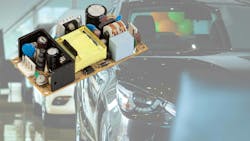Pinpointing the Best DC-DC Converter for Your EV Design (Download)
At the heart of modern electric vehicles is the DC-DC converter. It delivers the right operating voltage to specific components and enables the high-voltage, main battery pack to feed power to the crucial lower-voltage systems that control vehicle operations and provide creature comforts to occupants.
Some DC-DC converters can be crafted to transfer from the input to the output, in only one direction. But the majority of DC-DCs can be made bidirectional, which is especially useful for implementing regenerative braking.
